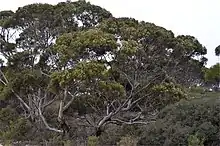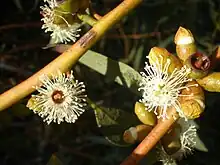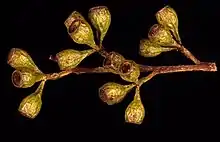| Yorrell | |
|---|---|
 | |
| E. gracilis in the Lincoln National Park | |
| Scientific classification | |
| Kingdom: | Plantae |
| Clade: | Tracheophytes |
| Clade: | Angiosperms |
| Clade: | Eudicots |
| Clade: | Rosids |
| Order: | Myrtales |
| Family: | Myrtaceae |
| Genus: | Eucalyptus |
| Species: | E. gracilis |
| Binomial name | |
| Eucalyptus gracilis | |
Eucalyptus gracilis, commonly known as yorrell, snap and rattle, red mallee, white mallee[2] or kong mallee,[3][4] is a species of mallee or small tree endemic to Australia, where it is found in south-western New South Wales, Victoria, South Australia and Western Australia. It has smooth white bark, usually with rough, fibrous or flaky bark on the lower stems, linear to narrow lance-shaped adult leaves, flower buds in group of between seven and eleven and cup-shaped, cylindrical or barrel-shaped fruit.[5][6]


Description
Eucalyptus gracilis is an open to spreading, multi-stemmed mallee or tree that typically grows to a height of 7 m (23 ft) but sometimes to 20 m (66 ft). It has smooth white, grey and coppery-cream bark, but usually rough, fibrous or flaky bark at the base of the stems. Young plants and coppice regrowth have linear to narrow lance-shaped leaves 33–90 mm (1.3–3.5 in) long and 9–18 mm (0.35–0.71 in) wide. Adult leaves are arranged alternately, the same glossy green on both sides, linear to narrow lance-shaped or curved, 45–110 mm (1.8–4.3 in) long and 4–17 mm (0.16–0.67 in) wide on a petiole 5–15 mm (0.20–0.59 in) long. The flower buds are arranged in groups of seven, nine or eleven on an unbranched peduncle 5–15 mm (0.20–0.59 in) long and square in cross-section, the individual buds on pedicels 2–5 mm (0.079–0.197 in) long. Mature buds are club-shaped, 3–7 mm (0.12–0.28 in) long and 3–5 mm (0.12–0.20 in) wide with a flattened to rounded operculum. It blooms between March and October producing creamy-white flowers. The fruit is a woody cup-shaped, cylindrical or barrel-shaped capsule 4–8 mm (0.16–0.31 in) long and 3–7 mm (0.12–0.28 in) wide with the valves enclosed.[7][8][9][10][11][12]
Taxonomy and naming
Eucalyptus gracilis was first formally described by the botanist Ferdinand von Mueller in 1855 in Transactions and Proceedings of the Victorian Institute for the Advancement of Science, from specimens collected "in the desert on the Murray River".[13][14] The species name is the Latin adjective gracilis "slender", likely referring to its branches and habit.[2]
Eucalyptus yilgarnensis was formerly considered a subspecies of this species.[2][15]
Distribution and habitat
Yorrell grows on sand dunes and plains, crests of rises and along creek lines in the Eremaean and South West botanical regions of Western Australia where it grows in sandy-clay-loamy soils over limestone.[9] It is found throughout most of southern and central South Australia where it grows in mallee shrubland in a range of soils, often over limestone. In Victoria it is confined to the north-west of the state, mostly in the Big Desert and Sunset Country, east to Manangatang. It also occurs in south western New South Wales where it is found in mallee shrubland on red aeolian sands south from Yathong and west from West Wyalong.[6][8][10][12]
Cultivation
E. gracilis is often cultivated in open areas, wider verges, in parks and reserves and as a shelter wind-break or for erosion control. It is also known to be good for honey production. Nectar-eating birds and insects use it for food and habitat. The yellow-tailed black cockatoo consumes the seeds of this species.[6]
 Eucalyptus gracilis foliage and blossoms
Eucalyptus gracilis foliage and blossoms Mallees near Calperum, South Australia
Mallees near Calperum, South Australia
References
- ↑ "Eucalyptus gracilis". Australian Plant Census. Retrieved 22 July 2019.
- 1 2 3 Elliot, Rodger W.; Jones, David L.; Blake, Trevor (1992). Encyclopaedia of Australian Plants Suitable for Cultivation: Vol. 4: Eu-Go. Port Melbourne: Lothian Press. pp. 106–07. ISBN 0-85091-213-X.
- ↑ Nicolle, Dean (2013). Native Eucalypts of South Australia. Adelaide: Dean Nicolle. pp. 98–99. ISBN 9780646904108.
- ↑ Dean Nicolle. "Native Eucalypts of South Australia". Retrieved 22 October 2016.
- ↑ "New South Wales Flora Online: Eucalyptus gracilis". Royal Botanic Gardens & Domain Trust, Sydney, Australia.
- 1 2 3 "Eucalyptus gracilis Yorrell". Plant Selector. Retrieved 6 May 2017.
- ↑ "Eucalyptus gracilis". Euclid: Centre for Australian National Biodiversity Research. Retrieved 2 June 2020.
- 1 2 "Eucalyptus gracilis F.Muell". PlantNet. Royal Botanic Garden, Sydney. Retrieved 6 May 2017.
- 1 2 "Eucalyptus gracilis". FloraBase. Western Australian Government Department of Biodiversity, Conservation and Attractions.
- 1 2 Brooker, M. Ian H.; Slee, Andrew V. "Eucalyptus gracilis". Royal Botanic Gardens Victoria. Retrieved 22 July 2019.
- ↑ Chippendale, George M. "Eucalyptus gracilis". Flora of Australia. Australian Biological Resources Study, Department of the Environment and Energy, Canberra. Retrieved 22 July 2019.
- 1 2 "Eucalyptus gracilis". South Australian Seed Conservation Centre, Botanic Gardens of South Australia. Retrieved 22 July 2019.
- ↑ "Eucalyptus gracilis". APNI. Retrieved 22 July 2019.
- ↑ von Mueller, Ferdinand (1855). Transactions and Proceedings of the Victorian Institute for the Advancement of Science. Collins Street: George Robertson. p. 35. Retrieved 22 July 2019.
- ↑ "Eucalyptus gracilis". APNI. Retrieved 22 July 2019.